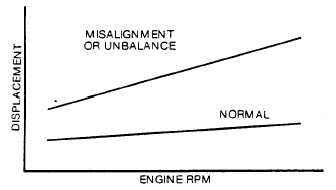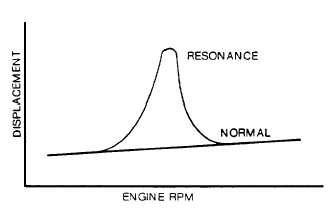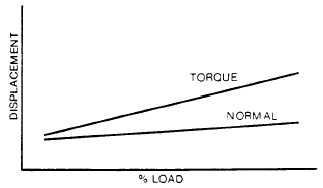LINEAR VIBRATION
TESTING AND ADJUSTING
Misalignment or Unbalance
Most linear vibrations of generator sets are caused by
misalignment or unbalance of the rotating members.
This results in first order vibration which can be
corrected in the field.
The vibration motion is relatively constant over the
speed range but exceeds accepted limits. For generator
set applications this may be determined by operating
between 45 Hz to 65 Hz. Load does not change
vibration motion caused by unbalance.
Figure 5
Resonance
Large vibration motion (amplitude) occurs within a
narrow speed range. This can occur on the generator
set and/or the attached equipment, such as piping, air
cleaners, etc. When vibrations "peak out" in a narrow
speed range, the vibrating component is in resonance.
Resonance occurs when the disturbing force in the
engine has the same frequency as the natural frequency
of the part which is vibrating. The force of the vibration
is, therefore, added to each cycle of the vibration part
causing magnification of the original vibration.
Figure 6
Torque Reaction
The vibration motion increases as load is applied. With
a two-bearing generator, it can be caused by insecure
mounting of the engine or generator to its base and/or by
a base not sufficiently rigid to withstand the associated
forces.
Figure 7
Torque reaction problems are not found with close-
coupled two-bearing or single-bearing generators. The
rigid joint between the flywheel housing and the
generator body is generally adequate to withstand
torque.
Assuming that a two-bearing generator is mounted on a
weak base, first order motion and orders related to the
number of cylinders firing with one crankshaft revolution
are due to torque reaction which, in turn, causes
misalignment. In this case, the first order motion would
be most prevalent. A few engines do not follow the
cylinder firing rule. These are the D346 and 0379 with
second order and the D349 and 0399 with fourth order,
in addition to the first order motion.
Certain specific causes of linear vibration can be further
identified:
Vibration Frequency
Correctable Causes
1/2 x Engine rpm
Misfiring of One or
(1/2 Order)
More Cylinders
1 x Engine rpm
Unbalance, Misalignment
(1st Order)
Out of Time Balance
Weights (3408), Crank-
case Overfill
2 x Engine rpm
Unbalance, Out of Time
(2nd Order)
Balance Weights,
Rotating Twice Engine
Speed (3304, D346, D379
1-1/2, 2-1/2, 3rd
Normal Cylinder Combus-
and Higher Orders
tion (Not Correctable)
105







